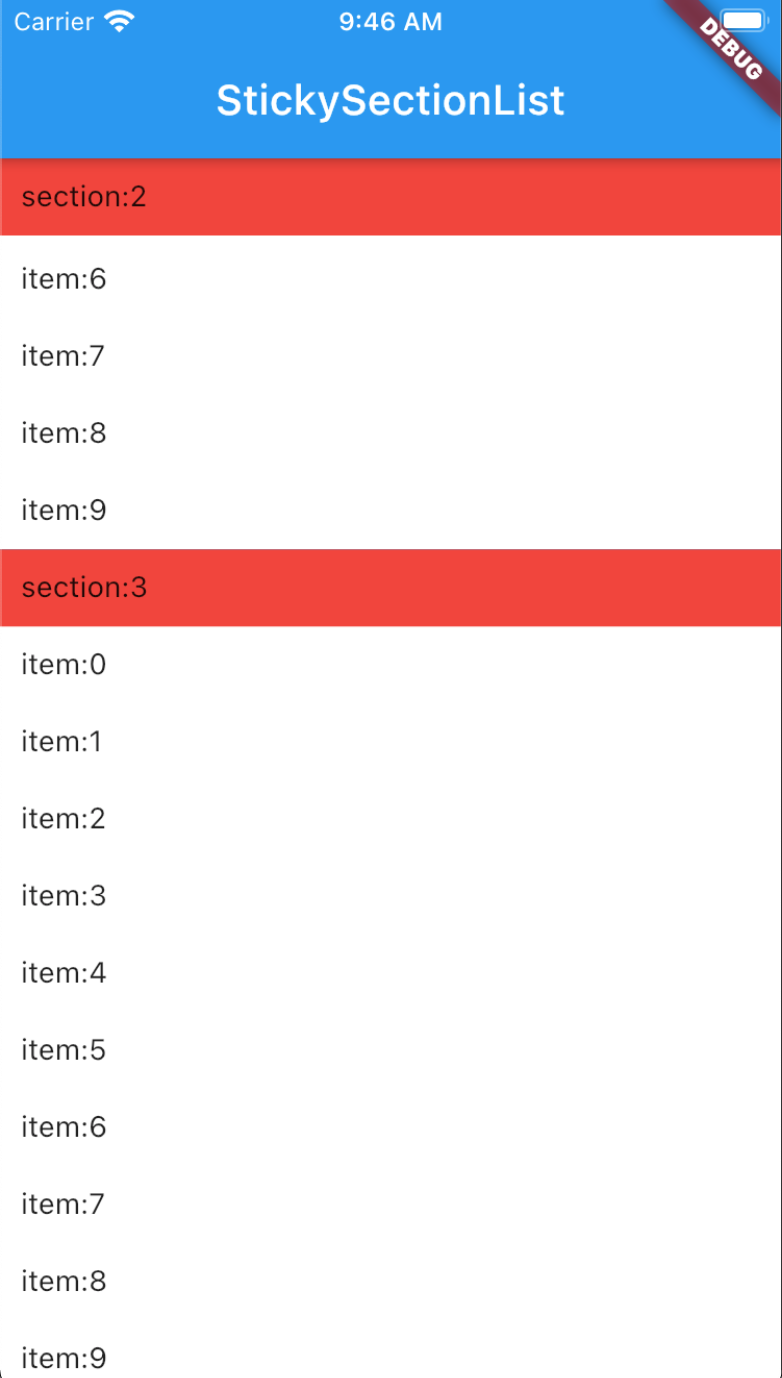Flutter粘性分区列表插件flutter_sticky_section_list的使用
Flutter粘性分区列表插件flutter_sticky_section_list的使用
flutter_sticky_section_list 是一个用于在Flutter应用中实现粘性分区列表的插件。下面是一个完整的示例demo,展示如何使用这个插件。
示例代码
首先,我们需要创建一个基本的Flutter应用,并引入 flutter_sticky_section_list 插件。以下是完整的示例代码:
import 'package:flutter/material.dart';
import 'package:flutter_sticky_section_list/sticky_section_list.dart';
void main() {
runApp(MyApp());
}
class MyApp extends StatelessWidget {
// This widget is the root of your application.
@override
Widget build(BuildContext context) {
return MaterialApp(
title: 'StickySectionList',
theme: ThemeData(
primarySwatch: Colors.blue,
visualDensity: VisualDensity.adaptivePlatformDensity,
),
home: MyHomePage(title: 'StickySectionList'),
);
}
}
class MyHomePage extends StatefulWidget {
MyHomePage({Key? key, required this.title}) : super(key: key);
final String title;
@override
_MyHomePageState createState() => _MyHomePageState();
}
class _MyHomePageState extends State<MyHomePage> {
@override
Widget build(BuildContext context) {
return Scaffold(
appBar: AppBar(title: Text(widget.title)),
body: Container(
// 设置背景颜色为蓝色
color: Colors.blue,
child: StickySectionList(
delegate: StickySectionListDelegate(
// 返回分区的数量
getSectionCount: () => 10,
// 返回每个分区中的项目数量
getItemCount: (sectionIndex) => 10,
// 构建分区头部
buildSection: (context, sectionIndex) => Container(
// 设置分区头部背景颜色为红色
color: Colors.red,
child: Text("section:$sectionIndex"),
padding: EdgeInsets.all(10), // 设置内边距
),
// 构建每个分区中的项目
buildItem: (context, sectionIndex, itemIndex) => Container(
// 设置项目背景颜色为白色
color: Colors.white,
child: Text("item:$itemIndex"),
padding: EdgeInsets.all(10), // 设置内边距
),
)),
));
}
}
运行效果截图
以下是运行上述代码的效果截图:

代码解释
-
导入必要的包:
import 'package:flutter/material.dart'; import 'package:flutter_sticky_section_list/sticky_section_list.dart';这里我们导入了Flutter的基本组件和
flutter_sticky_section_list插件。 -
创建主应用类:
class MyApp extends StatelessWidget { @override Widget build(BuildContext context) { return MaterialApp( title: 'StickySectionList', theme: ThemeData( primarySwatch: Colors.blue, visualDensity: VisualDensity.adaptivePlatformDensity, ), home: MyHomePage(title: 'StickySectionList'), ); } }这个类是应用的根部件,设置了主题和主页。
-
创建主页面类:
class MyHomePage extends StatefulWidget { MyHomePage({Key? key, required this.title}) : super(key: key); final String title; @override _MyHomePageState createState() => _MyHomePageState(); }这个类定义了主页面,并管理其状态。
-
构建粘性分区列表:
class _MyHomePageState extends State<MyHomePage> { @override Widget build(BuildContext context) { return Scaffold( appBar: AppBar(title: Text(widget.title)), body: Container( color: Colors.blue, child: StickySectionList( delegate: StickySectionListDelegate( getSectionCount: () => 10, getItemCount: (sectionIndex) => 10, buildSection: (context, sectionIndex) => Container( color: Colors.red, child: Text("section:$sectionIndex"), padding: EdgeInsets.all(10), ), buildItem: (context, sectionIndex, itemIndex) => Container( color: Colors.white, child: Text("item:$itemIndex"), padding: EdgeInsets.all(10), ), )), )); } }
更多关于Flutter粘性分区列表插件flutter_sticky_section_list的使用的实战系列教程也可以访问 https://www.itying.com/category-92-b0.html
更多关于Flutter粘性分区列表插件flutter_sticky_section_list的使用的实战系列教程也可以访问 https://www.itying.com/category-92-b0.html
当然,我可以为你提供一个关于如何使用 flutter_sticky_section_list 插件的示例代码。flutter_sticky_section_list 是一个用于在 Flutter 中创建粘性分区列表的插件,它允许你创建带有粘性头部(或尾部)的分区列表。
首先,确保你已经在 pubspec.yaml 文件中添加了 flutter_sticky_section_list 依赖:
dependencies:
flutter:
sdk: flutter
flutter_sticky_section_list: ^x.y.z # 请替换为最新版本号
然后运行 flutter pub get 来获取依赖。
以下是一个使用 flutter_sticky_section_list 创建粘性分区列表的示例代码:
import 'package:flutter/material.dart';
import 'package:flutter_sticky_section_list/flutter_sticky_section_list.dart';
void main() {
runApp(MyApp());
}
class MyApp extends StatelessWidget {
@override
Widget build(BuildContext context) {
return MaterialApp(
title: 'Flutter Sticky Section List Demo',
theme: ThemeData(
primarySwatch: Colors.blue,
),
home: MyHomePage(),
);
}
}
class MyHomePage extends StatelessWidget {
final List<SectionData> sectionDataList = [
SectionData(
title: 'Section 1',
items: ['Item 1-1', 'Item 1-2', 'Item 1-3'],
),
SectionData(
title: 'Section 2',
items: ['Item 2-1', 'Item 2-2'],
),
SectionData(
title: 'Section 3',
items: ['Item 3-1', 'Item 3-2', 'Item 3-3', 'Item 3-4'],
),
];
@override
Widget build(BuildContext context) {
return Scaffold(
appBar: AppBar(
title: Text('Sticky Section List Demo'),
),
body: StickySectionList(
sectionDataList: sectionDataList,
itemBuilder: (context, index, sectionData, itemData) {
return ListTile(
title: Text(itemData),
);
},
headerBuilder: (context, index, sectionData) {
return Container(
color: Colors.blue[300],
padding: EdgeInsets.symmetric(horizontal: 16.0, vertical: 8.0),
child: Text(
sectionData.title,
style: TextStyle(color: Colors.white),
),
);
},
),
);
}
}
class SectionData {
final String title;
final List<String> items;
SectionData({required this.title, required this.items});
}
在这个示例中:
MyApp是应用程序的根 widget。MyHomePage是主页面,包含粘性分区列表。SectionData是一个简单的数据类,用于存储每个分区的标题和项。StickySectionListwidget 用于创建粘性分区列表。它接受以下参数:sectionDataList:一个包含SectionData实例的列表。itemBuilder:一个用于构建分区中每个项的回调。headerBuilder:一个用于构建分区头部的回调。
运行这个代码,你将看到一个带有粘性头部的分区列表,每个分区头部都会随着用户滚动而保持在其分区项的顶部。








